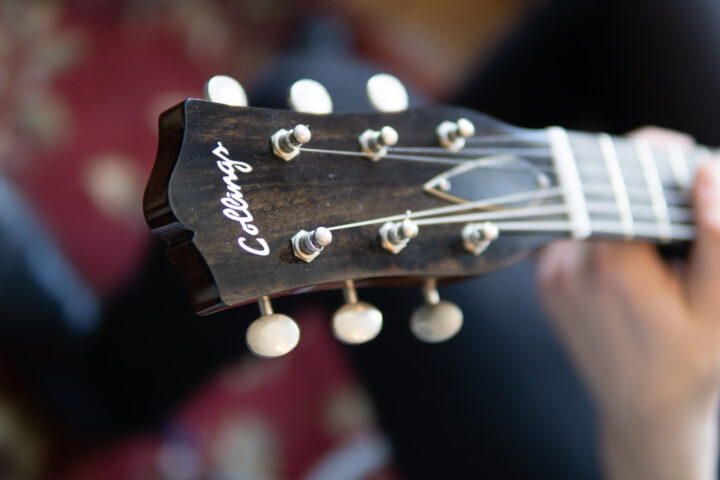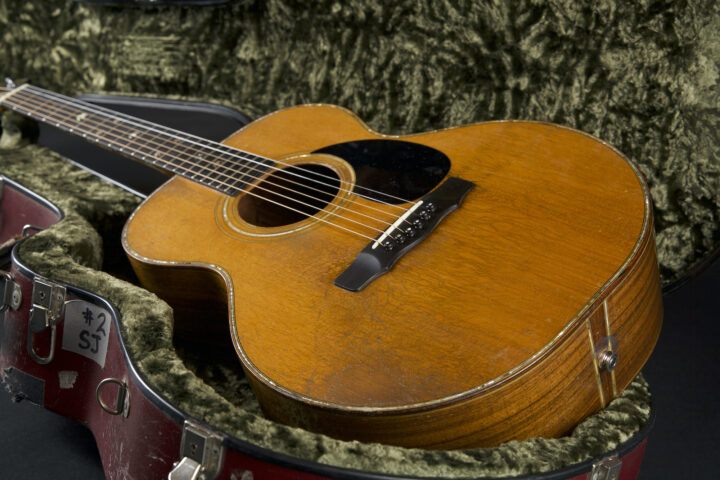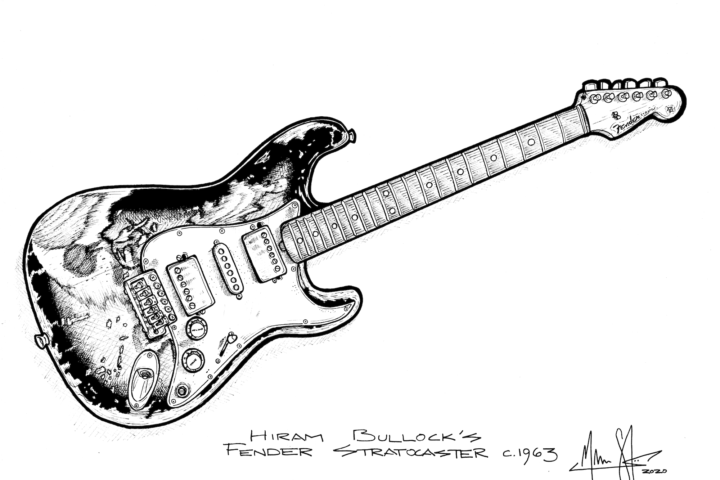Julien’s Auctions has announced that, on June 19, 2020, Prince’s “Blue Angel” Cloud guitar (pictured above, courtesy Julien’s) will be auctioned with an estimate is $400,000-600,000. Though many Cloud copies exist, this particular guitar was Prince’s primary performance instrument from 1984 (when it was built) to 1993. Fretboard Journal contributor John Woodland helped verify the instrument’s provenance and, given the news, we’re reprinting the Cloud history that he and Gerald Ronning published in the FJ #45 here. It’s a fascinating snapshot into the iconic (and confusing) Cloud guitar’s history.
These are excerpts from Woodland and Ronning’s forthcoming book, Look Up in the Air: The Origin of Prince’s Cloud Guitar. Included will be information on the store where the Cloud Guitars were made, Knut Koupée Music, as well as the luthiers that worked there between 1983 and 1985. The book will combine the features of a historical whodunnit with a broader cultural history of the Minneapolis music scene and the talented craftspeople and artists who supported it in the 1980s.
From Chapter 2: The O’Hagan Connection
I was halfway through my my studies in Red Wing Technical College’s stringed instrument program in 1991 when I interviewed for the repair shop at Knut Koupée, the famed music store that for a time served as the guitar-maker for Prince. Knowing that this was the home of the Cloud Guitar featured in the film Purple Rain, I expected a luthier’s paradise of woodworking tools, replete with a library of guitar jigs, perhaps even the jig for the Cloud Guitar itself.
What I saw, however, was a sad, windowless basement with a very used bandsaw, router table, drill press, horizontal sander and some random hand tools. Certainly, something could be made here, but the Cloud Guitar? It was inconceivable. I was 19 at the time and had been in contact with Minnesota luthiers Jim Olson and Roger Benedict, as well. I wanted to focus on and build acoustic guitars, and working in Olson’s shop would be the ultimate gig. Jim said he rarely took on apprentices, but I apparently caught him at the right time, as his backlog was starting to get daunting, but he told me he was strictly a builder and that there would be no incoming repairs. If I wanted to study how to repair and build I should look elsewhere.
I took his advice, and instead was bench-tested for three months by Roger Benedict. I got the job. As I got to know him, Roger shared that before he started his store in 1981, he built for the Minnesota guitar company O’Hagan Guitars. At one point, Roger told me that the white guitar Prince used in the movie Purple Rain was built from an O’Hagan Shark model guitar. I was baffled, but as I would later find out, it was something that had just been known around town.
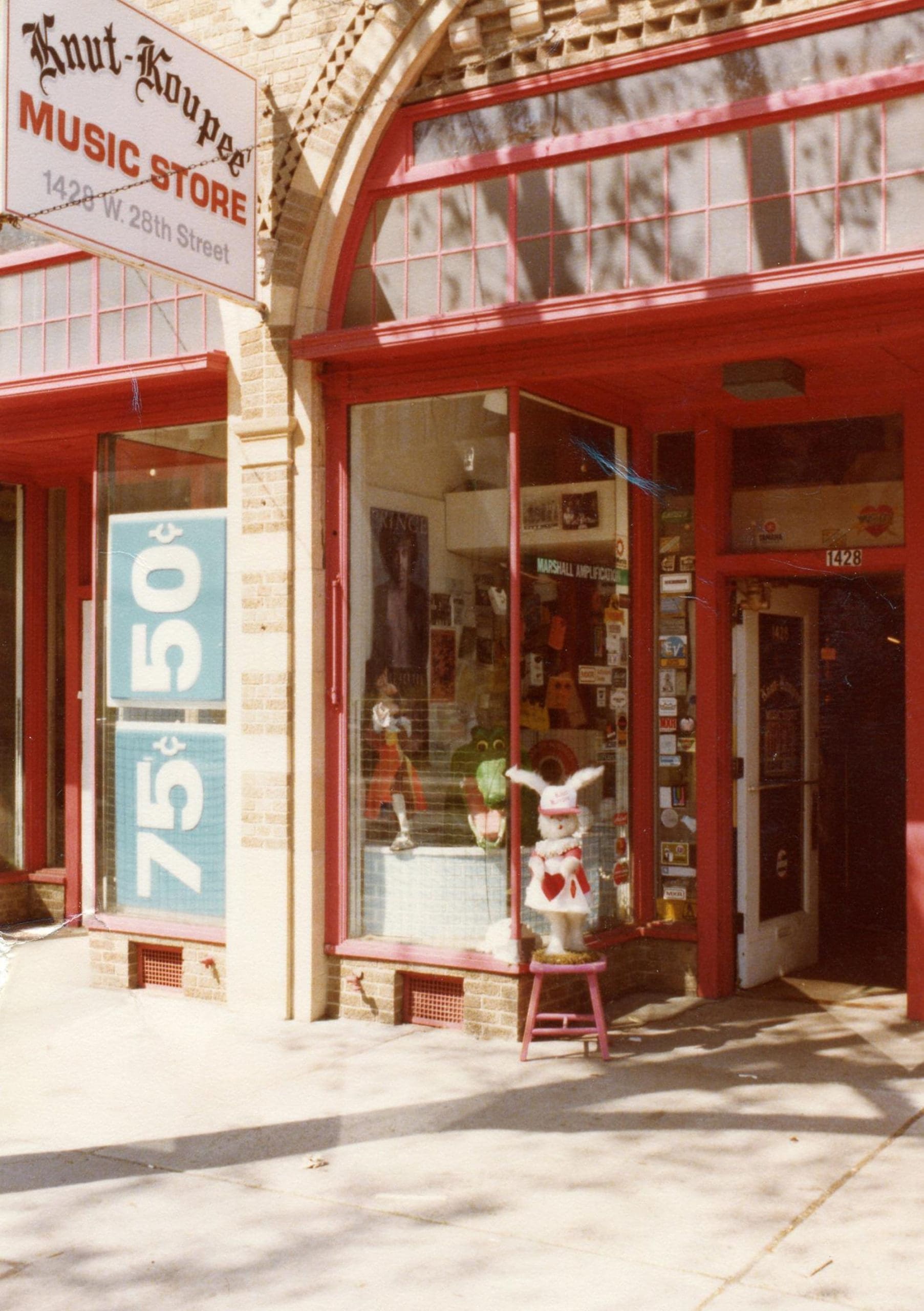
Knut Koupée proudly displaying Prince’s For You album poster in the window, circa 1978. Photo courtesy of the Errol Joki Collection
Knut Koupée’s former employees relate a few different versions of what actually happened in the basement shop 36 years ago, but luthier Dave Rusan tells what has become the most widely accepted version of the Cloud Guitar’s origins. According to Rusan, when he arrived back to Minneapolis in November 1983 from a stint working at a music store in London, England, he immediately went back to work at his former employer, Knut Koupée. Rusan was the first guitar tech hired by the store in the mid-1970s and worked there on and off for the next decade. He recalls that “Prince had a meeting with Jeff [Hill, co-owner of Knut Koupée] and they went in the back room. I remember that they were already starting on [Purple Rain]. They were already doing things, whatever you do, pre-production or maybe some of the acting scenes, I don’t know. But Prince had a meeting with Jeff.” According to Rusan, after that meeting, Hill instructed him to build the first Cloud Guitar.
Prince brought in a uniquely shaped bass that he wanted this new guitar modeled after. Rusan remembers the bass as “basically a weird piece of shit. It had no truss rod and it had bar frets. That’s all I remember.” Rusan remembers that Prince “had certain specific things he wanted [in the new guitar] that were relayed to me: It had to be white, it had to have gold hardware, it had to have EMGs. He wanted spade markers and he wanted features of that bass, the horn and such, but reimagined as a guitar, and that was about it.” Rusan notes that Jeff Hill communicated these few specifications to him. Rusan said he “never talked directly to Prince once. Sometimes I’d try and get roadies to ask him stuff, and even then, it was hard.”
An agreement on the “Customized Guitar” was drafted and signed by store co-owner Karl Dedolph and Prince Nelson. Rusan recalls that he “had drawn a new shape on a piece of paper. I don’t know if I traced the bass to begin with, but I don’t think so. I think at least part of it I had to redo from scratch.” Rusan also confirmed the story that Roger Benedict had told me in the early 1990s and what had been rumored in Minneapolis for decades: The first Cloud Guitar started its life as an O’Hagan Shark.
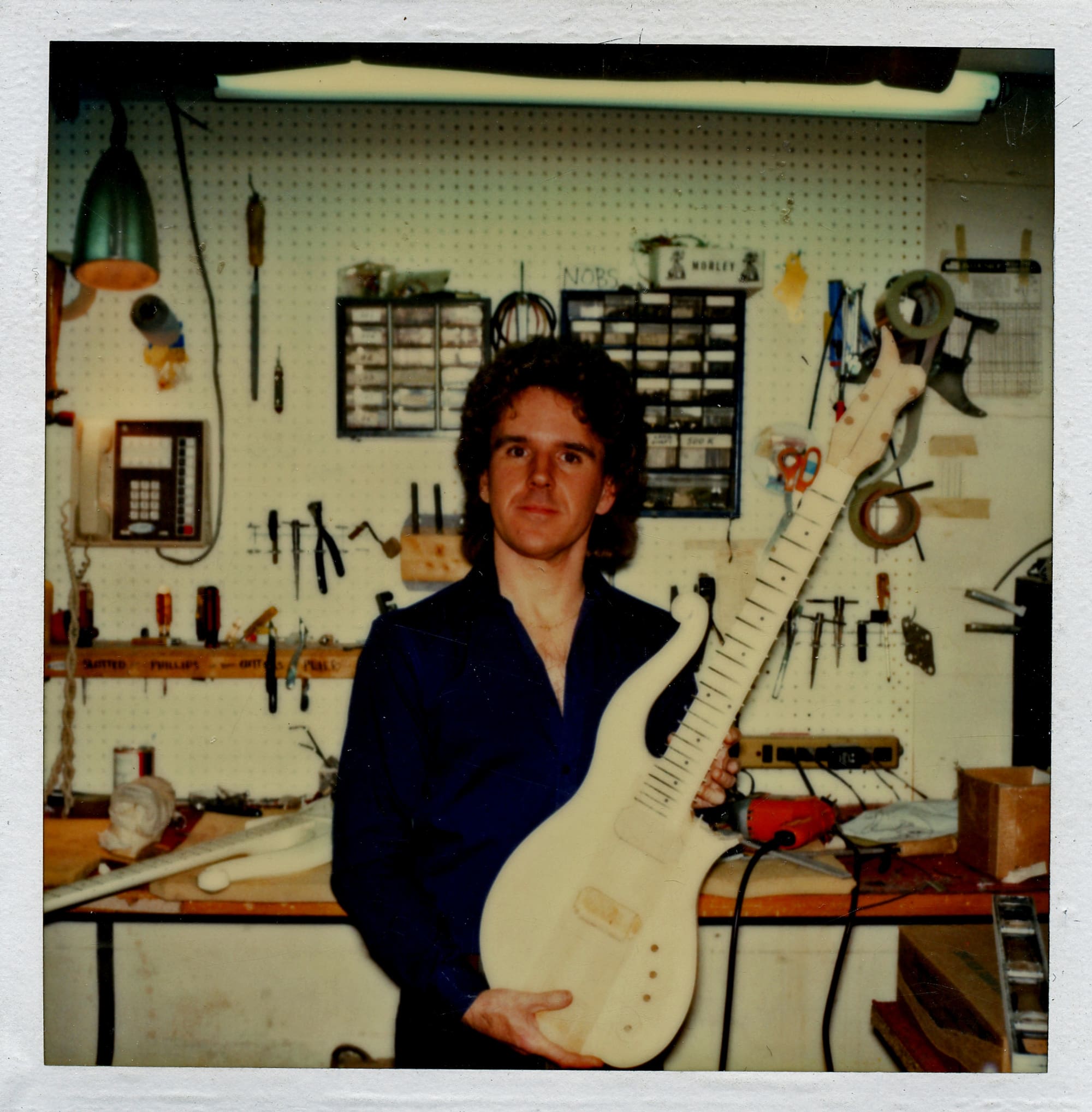
Dave Rusan in mid-1984, holding the unfinished second Cloud Guitar with the first Cloud Guitar behind him. Note the filled neck pickup rout and doweled tuner holes. This guitar started as an O’Hagan Nightwatch. Photo courtesy of the Errol Joki Collection
The sides of the Shark were cut off of the maple neck-through body design and new sides were grafted on. The neck pickup humbucker cavity rout was filled with wood to be later routed from the back side of the guitar for the smaller, EMG neck pickup, while the existing bridge pickup rout already accommodated the EMG Prince used. The existing tuner holes were filled and a little wingtip part of the headstock was grafted on from a new piece of wood. Rusan notes that “[o]nly the first two were made from O’Hagan necks—after that, I did them all from scratch.”
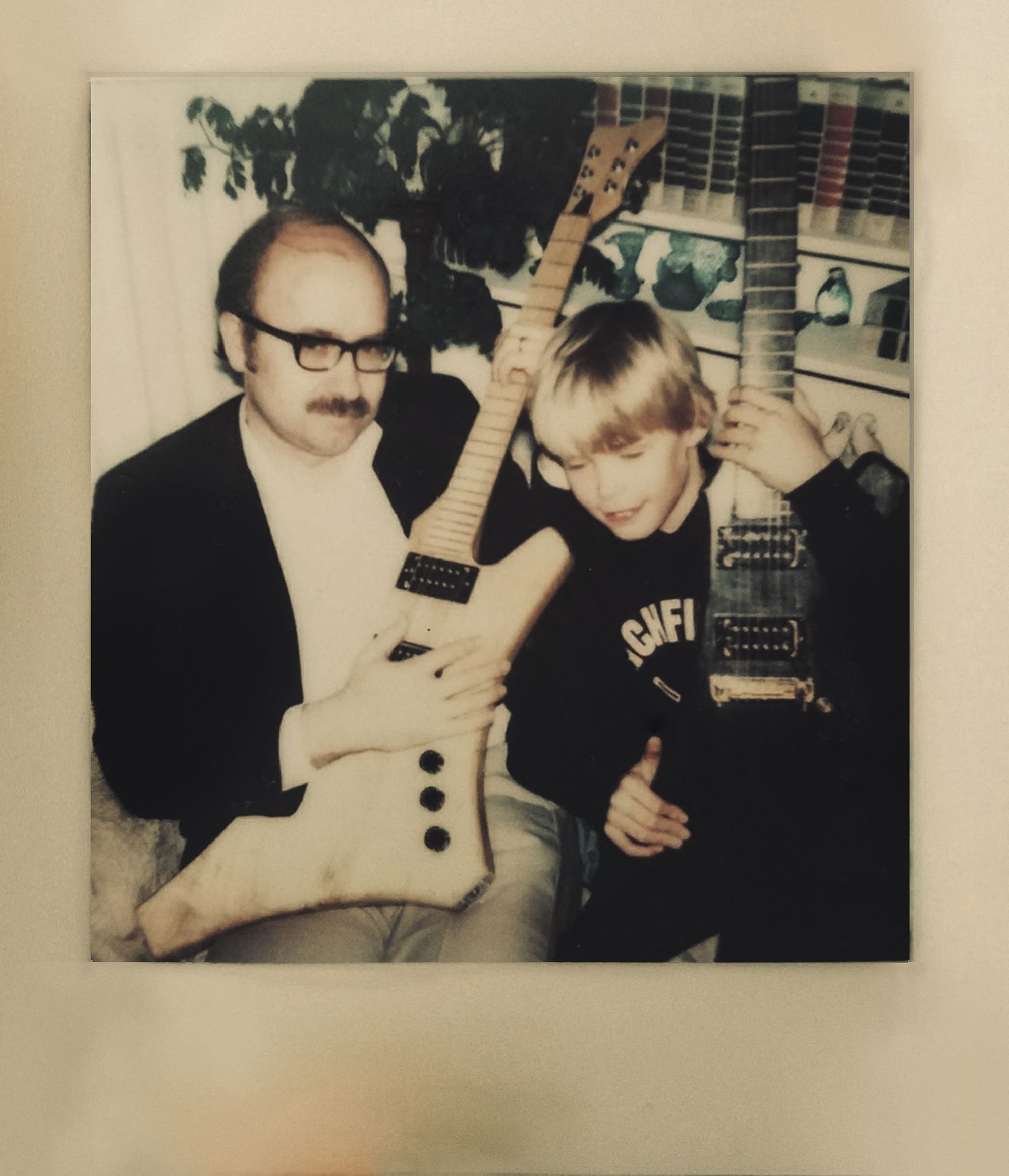
Jerry O’Hagan and son with O’Hagan Shark model guitars. Photo courtesy of the O’Hagan family
In the late-1970s, a Minnesota clarinetist named Jerry O’Hagan determined that he would break into the guitar business. He commissioned a local art teacher, Jim Imsdahl, to design a line of O’Hagan electric guitars that would be made in St. Louis Park, Minnesota, a suburb of Minneapolis. O’Hagan hired Jim Olson to make the jigs, and in 1979, the company debuted its first line of four instruments, including the Shark, inspired by Gibson’s Explorer, and the Nightwatch, a Les Paul Junior-style instrument, offered in both single- and double-cutaway versions. Examples of both of these models would eventually become platforms for the Knut-built Cloud Guitars. The Nightwatch featured a Roman ogee edge along the top perimeter, similar to a 381 Rickenbacker semi-hollowbody. The line was capped off with the Twenty Two model, a Gibson Flying V clone whose most famous user was the Time’s Terry Lewis, who ordered a custom Twenty Two bass in white, and the O’Hagan Laser, an oddly shaped neck-through Strat-style design.
O’Hagan initially hired space in which to paint the guitars from Minnesota luthier Chuck Orr, whom diehard Prince fans know as Prince’s first luthier, who built the guitar he plays in the video for “Why You Wanna Treat Me So Bad.” With a crew of young luthiers working in the St. Louis Park shop, Jerry O’Hagan seemed to be off to a good start, and from a distance, O’Hagan looked as if it might be Minnesota’s answer to Hamer Guitars. As Minnesota luthier and former O’Hagan employee David Seaton explains, “Things were good when I started, there were about 10 of us total employed at the shop.”
O’Hagan did not live up to its founder’s hopes, however. According to Seaton, in 1982, O’Hagan sales began to fall flat. By early 1983, paychecks started to bounce and the company started to lay off its staff. Seaton recalls, “My coworkers weren’t showing up to work, and the rest of us were trying to figure out what to do. One day, I came into work to see if I could get a new paycheck cut and there was this big truck there and they were loading up bins of guitars and tools that would eventually go to auction.” Apparently, O’Hagan had problems with the IRS and needed to clean house. O’Hagan sold the majority of its inventory and tools and persisted for two more years at a shop near the University of Minnesota campus in Minneapolis, until its final demise in 1985. “Jerry was proud of that guitar line, he put his heart into it, and it was painful for him to see it go out of business,” recalls his wife, Marianne O’Hagan. Jerry passed away on February 16, 2018.
One of the buyers of those bins of guitars, parts and tools in the spring of 1983 was Knut Koupée music, a South Minneapolis store founded in 1973 by Karl Dedolph and Jeff Hill, the man who took the order for the first Cloud Guitar in 1983. According to employees, Knut Koupée was initially a laughably small operation—at times maybe a half-dozen sets of strings and a couple of beat-up acoustics made up the store’s entire inventory.
But by the end of the 1970s, Knut had become a flourishing little shop benefiting from geography and an effervescent local music scene. Employees remember Karl as the more entrepreneurial of the two—or at least the one more interested in the deals than the instruments. Karl was unpredictable, mercurial and fun-loving, but also tended to see the store more as a business like any other. Customers and employees alike seem to agree that Jeff Hill was the guitar visionary. He saw the value in vintage guitars before they were vintage. Jeff was a decent player, he knew musicians and he exuded a ’70s rock charisma. He knew guitars, he talked guitars, he loved guitars, and it was in large part his vision that transformed Knut Koupée from a guitar seller into a guitar maker. Jeff and Karl expanded the repair shop and promoted the store’s guitar-building prowess; few local shops emphasized repairs, and marketing Knut’s shop made money and brought in potential customers.
The shop also helped Jeff and Karl overcome one of their more vexing obstacles: They could not sell new guitars from the most popular brands because other local stores had exclusive relationships with the manufacturers. Knut Koupée would flank their competition and make its own Knutocasters to order. The DIY ethic was strong at Knut and in its enterprising luthiers, and buying O’Hagan’s inventory of guitars (in various stages of completion) and parts and repurposing them was consistent with the shop’s entrepreneurial ethic.
When I interviewed Karl, he was brief and offered little to no information as to the design and construction of the Cloud Guitars and the role O’Hagan’s may have played. “We were buying parts from Schecter and other companies. We were just building guitars to what people wanted,” Dedolph explained. “So, I don’t know, it seemed like [using an O’Hagan] might have been a shortcut where the neck was set in, in this piece of wood.”
From Chapter 7: Jeff Levin and Sardonyx Guitars
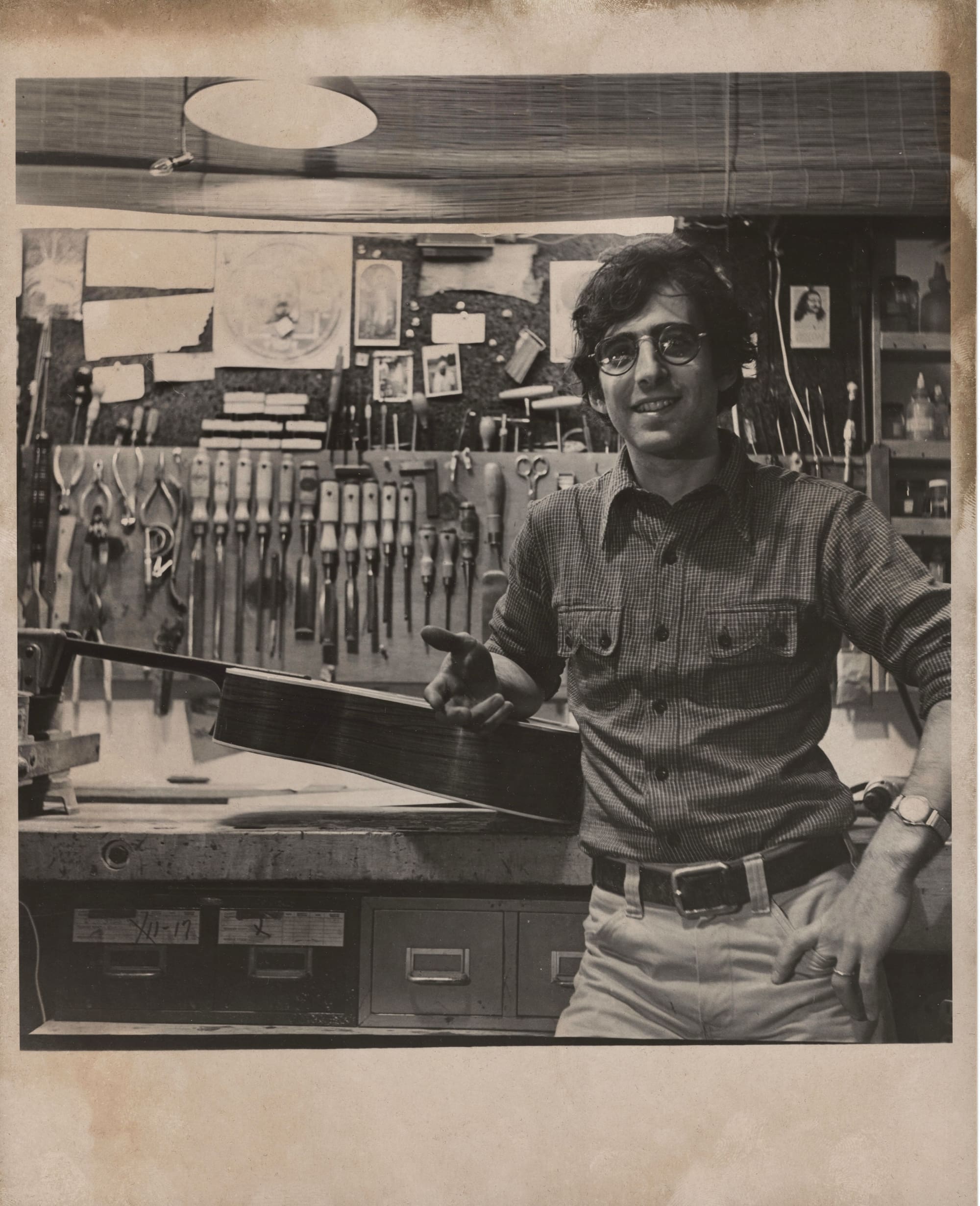
Jeff Levin at his Umanov Guitars workbench. Photo courtesy of Jeff Levin
According to rock & roll photographer and former Prince guitar tech Joel Bernstein, Prince said he was walking around New York City and saw the bass that inspired the Cloud Guitar in the window of a guitar store. “He said he was stunned and completely captivated by the shape. He felt it was very erotic, and he wanted to have it right away. He told me he had no money and that he figured out some way to put some money down on it and come back and get it. My impression is that he played it to death, he loved it. He loved everything about it.” The bass was designed and built by Jeff Levin of Sardonyx Guitars.
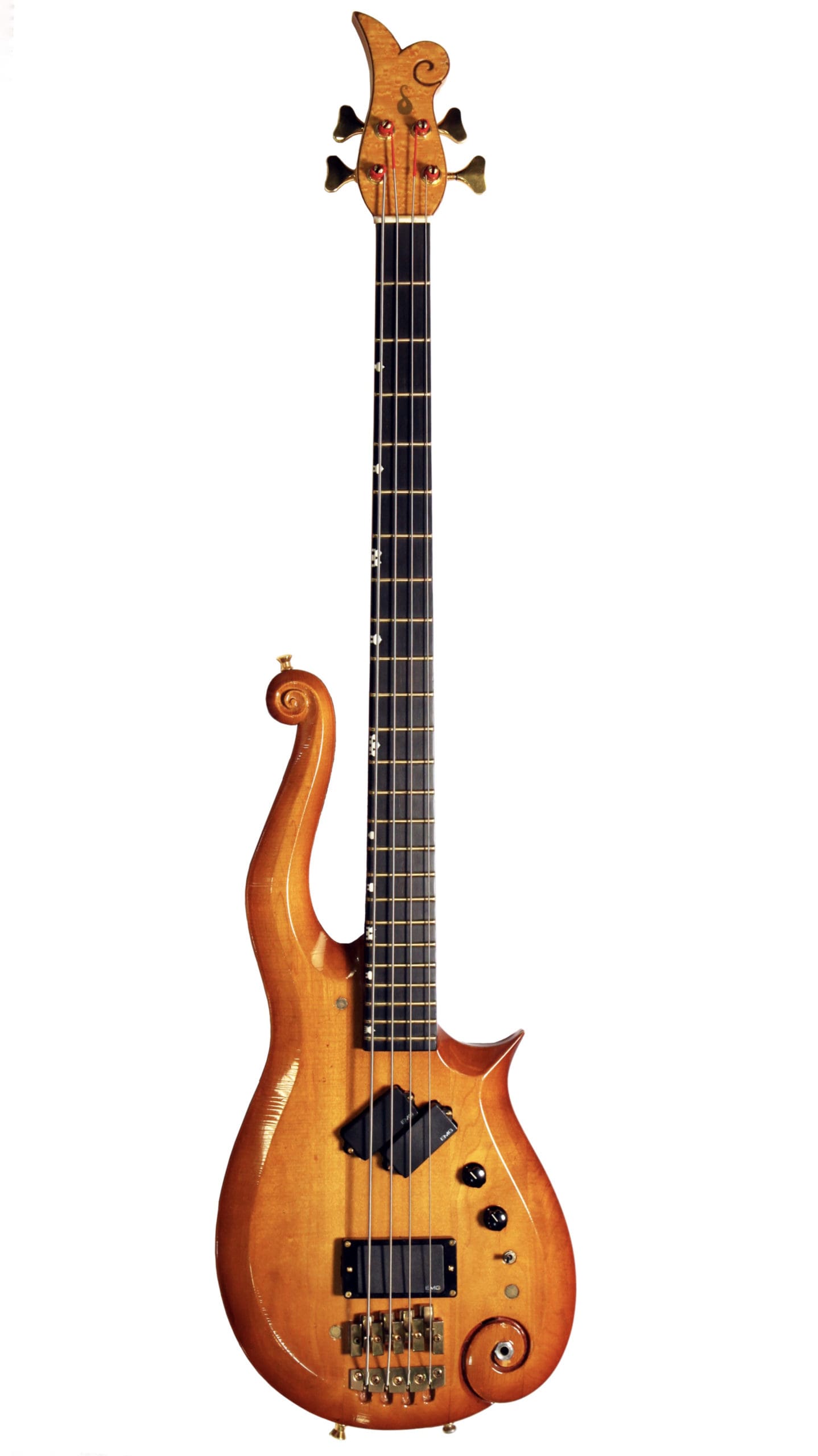
The one-off bass made by Jeff Levin of Sardonyx Guitars, 1972.
Levin worked as a luthier at Matt Umanov Guitars in New York City when it opened in 1965. Levin recalls that there “were very few people at that time that were building…[w]e were sort of the only game in town.” Levin made what he refers to as the F Bass for himself in 1972. “It was sort of an interesting project. The shape was basically based on the Gibson F-style mandolins, but to get it to balance I had to elongate the scroll.” The Taj Mahal-looking inlays on the fingerboard are a shape that Levin liked. “There’s nothing really anything about that. I just needed to have shapes that would differentiate the different frets, and the little cutouts kinda do that.” Levin fabricated the brass bridge system himself, and a hexagonal bar that went almost the entire length of the top above the pickups that was eventually removed. “It wasn’t something particularly useful, and it makes sense to take it off if you don’t like it.” Levin notes that the body and headstock design is “a derivation of that Florentine-style mandolin. If you look at the Gibson’s, it’s not that far removed. I like to give credit where credit’s due.”
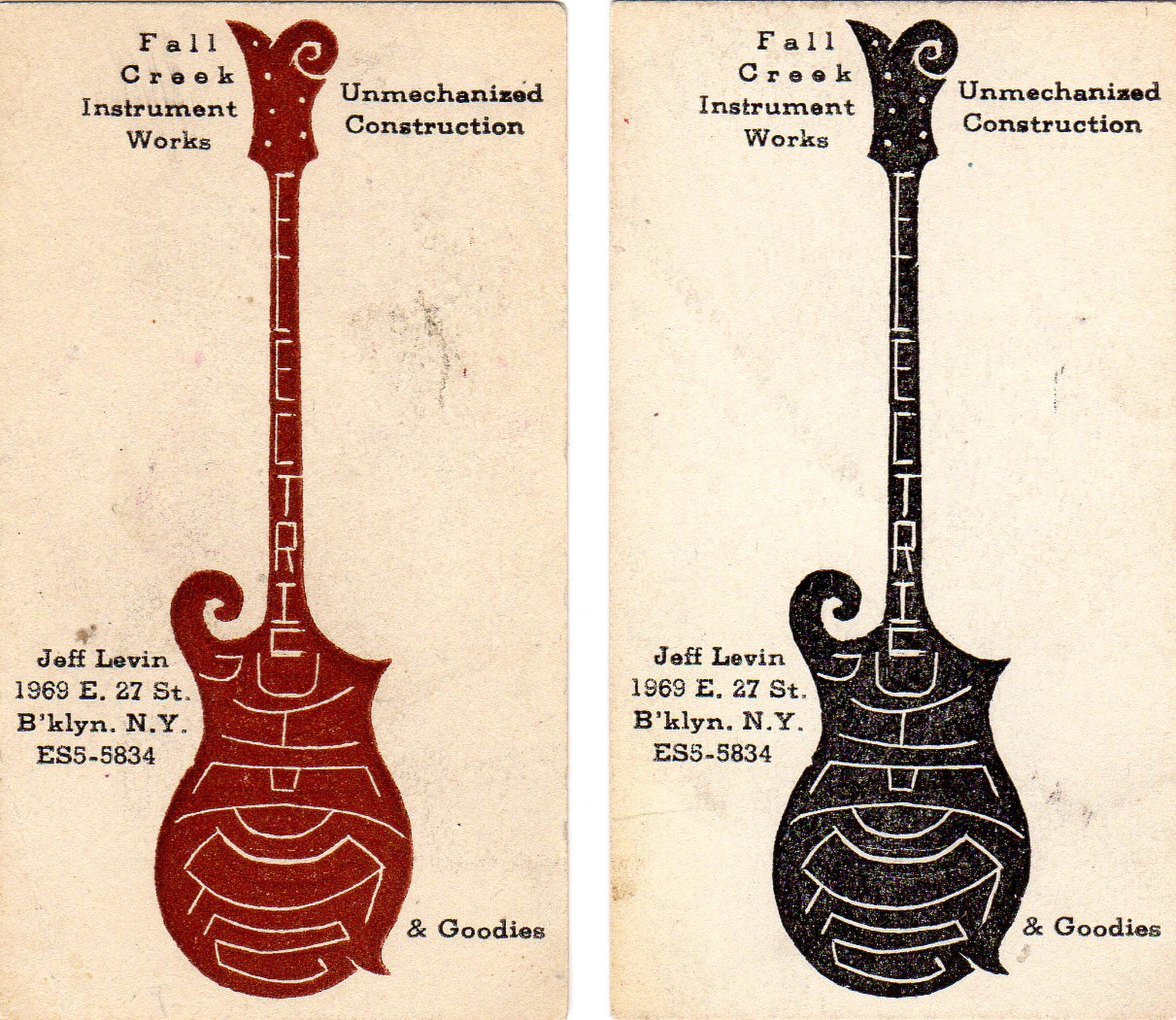
Jeff Levin’s late-1960s business cards, found buried in an envelope that also contained a June 9, 1971, Byrds backstage pass to the Fillmore East. Photo courtesy of Matt Umanov
Hired by Paisley Park in 2018 to do conservation work on his massive guitar collection, I’ve since held the Sardonyx bass personally, many times. Everything about Levin’s bass is beautifully executed. When I first picked it up at Paisley and played it, I could tell it was made by someone who understood and knew how to build instruments. The scrolled horn is angled back so it wouldn’t be over the neck and cover the fingerboard markers. It is hand-carved, and instead of rounding off the edges, Levin beveled them perfectly around the perimeter of the guitar to make it comfortable to play. The headstock has a veneered piece of rosewood under the maple veneer, and the swirl is cut down to the rosewood to show through. The compression bar fretting is a result of Levin’s years of experience working on pre-war Martin Guitars, and to this day still results in a perfectly straight neck with just the correct amount of relief, even without an adjustable truss rod. The sunburst finish is similar to the Martin F-style archtop acoustic guitars Levin was retopping into flattop guitars and finishing in the 1960s. The instrument looks like a twentieth build, not a one-off design. The lines and execution of his F-bass are well thought-out and obviously the genesis of the Cloud Guitar lines.
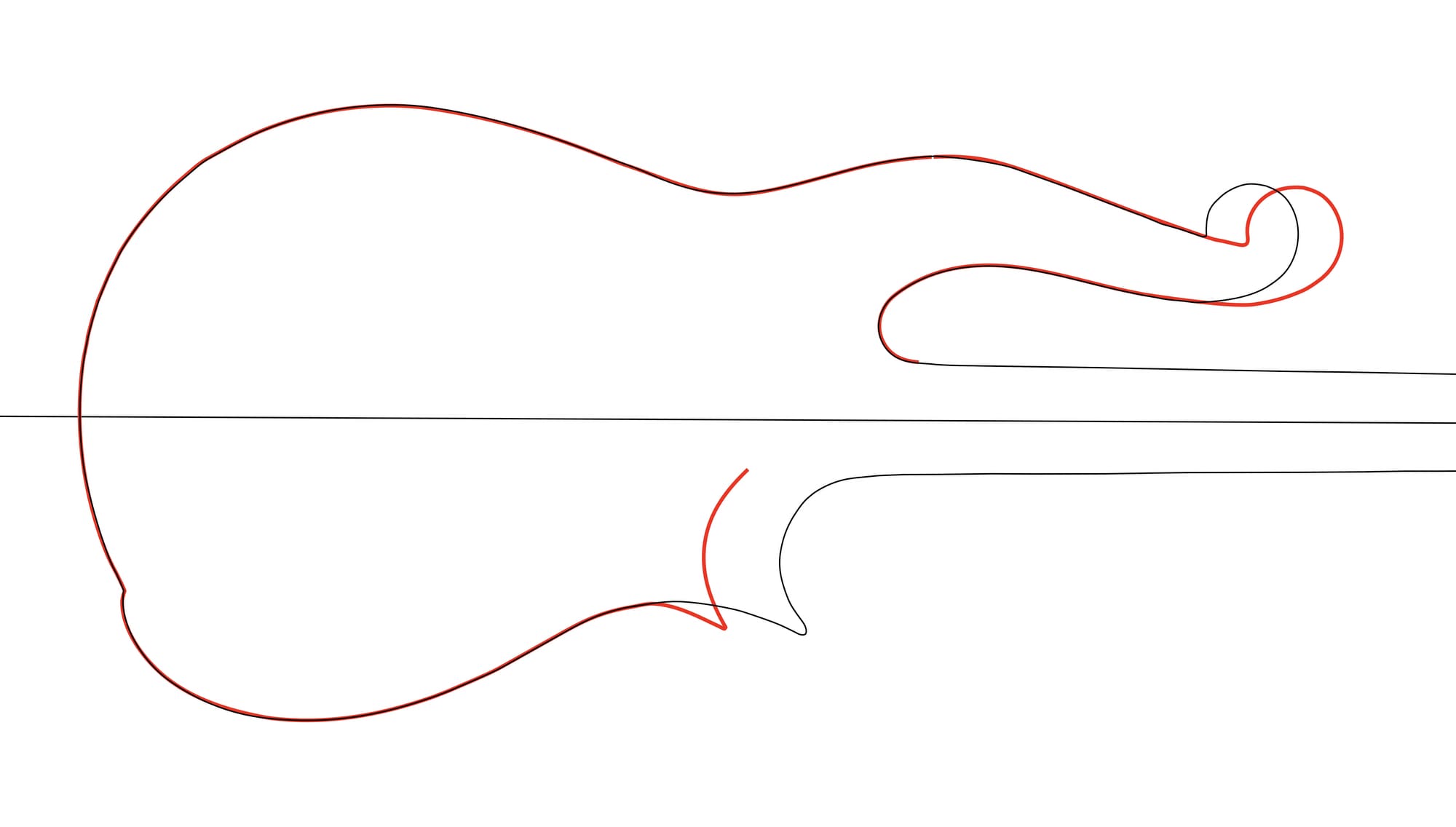
Tracings by John Woodland
I traced the shape of an original Cloud Guitar template that Knut luthier Barry Haugen had given me and traced the Sardonyx bass on top of that at Paisley Park to try to sort out the process of design. The Cloud Guitar template is identical to that of the bass in all respects except that the Cloud Guitar’s horn is three-quarters of an inch shorter and the cutaway location is slightly different, which would naturally shift due to the shorter scale length, but both are executed the exact same. The three-dimensional shape is directly copied from the bass as well, including the most distinctive feature of the guitar, the horn and scrollwork, even the angled design of the horn itself. The swirl design around the output jack area is also identical, as is the swirl design and left wing on the top of the headstock. The Cloud Guitars also have maple neck-through construction, like the bass. The beveled design around the perimeter of the body was also used for the Cloud Guitars, which is one inch from the edge. The fingerboard position markers are spades on the original Cloud Guitars, mimicking the spade-like shape of the fret markers on the bass.
There are a few differences. The bass guitar has four strings and the Cloud Guitar has six strings. The bass is a darker sunburst color, the first Cloud Guitars were white. The pickups are different, the potentiometers and switch location are different and the control cavity rout that houses these are unique to the Cloud Guitars. Although the overall headstock design is the same, the Cloud Guitars are slightly elongated to accommodate the additional tuners. The truss rod cover on Cloud Guitars are similar to O’Hagan Nightwatch covers, and there is no truss rod cover on the bass.
Not being much of a Prince fan and having never seen Purple Rain, Levin was shown an image of Prince and the Cloud Guitar in the mid-’80s. “I found out the hard way. I knew he bought it, and then someone sent me a picture of the guitar from the movie. Years later, when I was at the Smithsonian, I noticed they had one of those cloud guitars, a yellow cloud guitar, and they credited the builder, the guy that copied it was credited with it, but there was no credit for the guy who designed it. It was nice to see it, but I think if you’re going to be a museum, you have a responsibility for getting the history correct.”
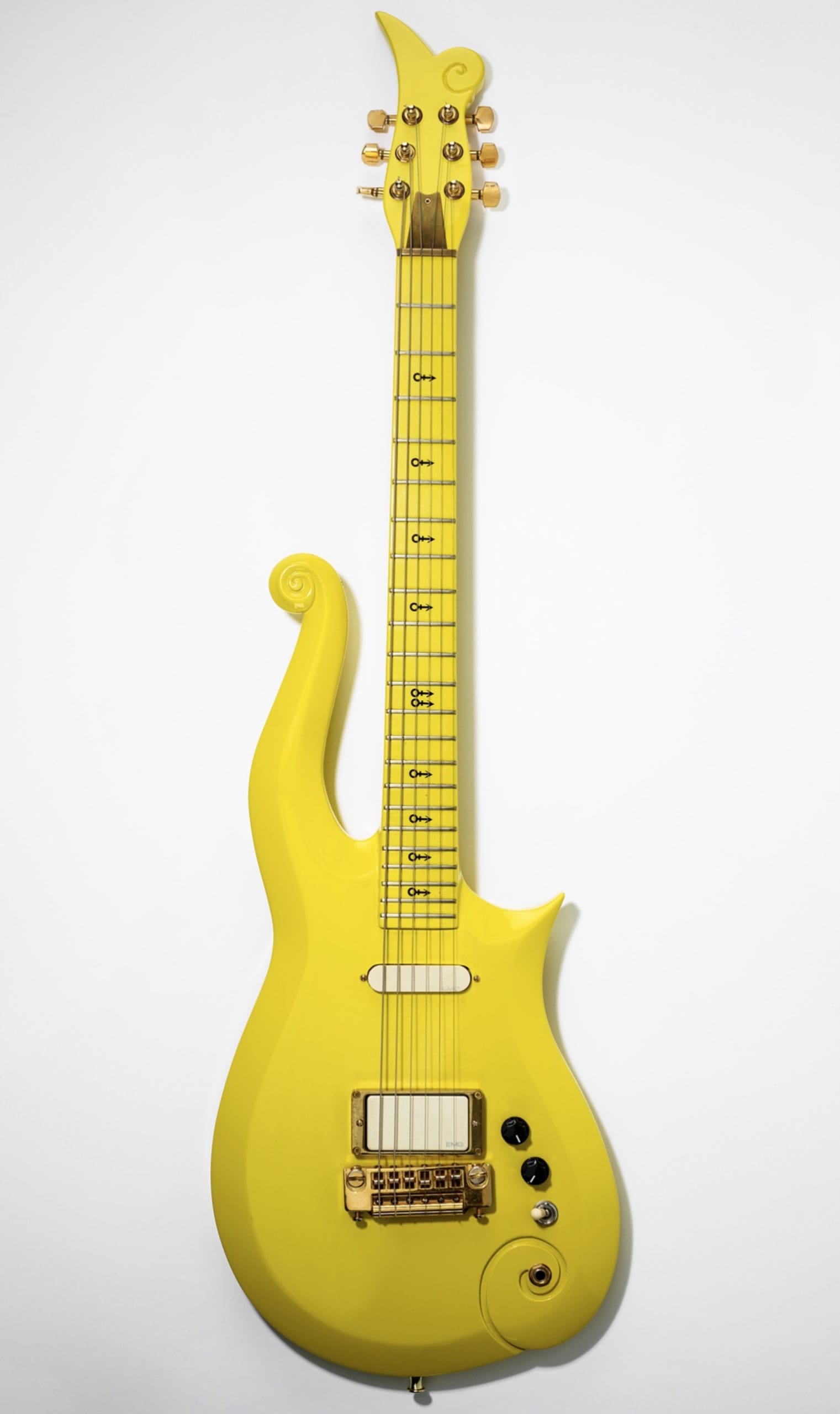
Photo courtesy of The Smithsonian Institution
Prince donated that yellow Cloud Guitar to the Smithsonian in 1993. He did not include any paperwork with the guitar, and his production manager, who arranged the donation, added nothing to its provenance. For years, the Smithsonian dated it to 1989, based on information a staff member at Paisley Park later gave them, and listed the builders as Dave Rusan and Barry Haugen.
However, Rusan does not believe that the Smithsonian Cloud Guitar is one of his. “It’s none of them,” he claims. “The Smithsonian isn’t any of those. There’s a rumor Barry Haugen made one and it’s that,” but Rusan doubts it. When I asked him what had happened to the first Cloud Guitars made for Prince, Rusan said, “All that Takumi [former guitar tech for Prince] could tell me is that when he started there [Paisley], there was at least the one with the narrow neck. Other than that, they all disappeared and nobody knows.”
“So, what’s the Smithsonian one, do you think?” I again asked Rusan.
“I know that it’s not one of mine, because I know what it’d look like and I know every little detail. I can tell exactly which one I did and which one I didn’t, and it’s not one of those.”
Note: The Prince Estate is not affiliated, associated or connected with this article, nor has it endorsed, commissioned or sponsored this article. Further, The Prince Estate has not licensed any of its intellectual property to the authors.
Order the Fretboard Journal #45 here.
